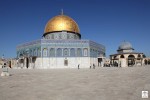Jerusalem(Joshua 10:1)The capital of the State of Israel and ancient capital of the Kingdom of Israel and later of Judah. A city sacred to the three principal monotheistic religions.Situated in the heart of the Judean Hills, 800 meters (2625 feet) above sea level on the crossroads of 2 major arteries: the north-south mountain route, and the road ascending from the Coastal Plain and Judean Foothills in the west and descending to the Jordan Valley and Transjordan in the east. It comprises the Old City, surrounded by a wall, and the new city, outside the wall. The Old City has 4 quarters: Jewish, Armenian, Moslem and Christian.The Name Jerusalem: In its most ancient form, the name of Jerusalem appears in the Egyptian Execration Texts, 19th-18th century BCE as Rushalimum. In the Middle Bronze Age its name was possibly a combination of 2 Canaanite words: Yru (foundation) and Slm (the name of a local god); combined – the foundation of the god Shalem. During the days of Abraham it was called Shalem (Genesis 14:18). In Tell el Amarna letters from the 14th century BCE the city is called Urusalim similar to the Biblical Yerushalem or Yerushalayim. During the period of Israelite conquest Joshua was not able to take the city and it remained a wedge separating the central tribes from those of the north and the south. Only in 1005 BCE, did King David capture the city of Jebus (as it was then called after its Jebusite inhabitants) and change its name to the City of David making it the capital of his kingdom.History: Flint tools found near Jerusalem demonstrate the area was inhabited as early as the Paleolithic Period. Sherds indicate permanent habitation from Early Bronze Age (approximately 3000 BCE). Some of these shards were found on the eastern hill of the ancient city, south of the Old City walls of today, above the Gihon spring.From 1000 BCE to 586 BCE, and from 515 BCE to 70 CE, it was the political, commercial and religious center of the Jewish nation. There are many finds associated with all periods of Jewish sovereignty over Jerusalem. For Christians, Jerusalem is associated with the life of Jesus. For Moslems, with Muhammad’s nocturnal journey to heaven.
Jerusalem at the time of Jesus: There are a multitude of Christian holy sites in Jerusalem, mainly within the Christian Quarter of the Old City. Many have been built over time to commemorate the life of Jesus which largely centered on the Jerusalem of the New Testament.Church of the Holy Sepulchre: The holiest place in Christendom. Complex of over 30 chambers and chapels, in the Christian quarter of the Old City. A conglomeration of Byzantine, Crusader and 19th century Greek construction. According to Christian tradition this is the site of Jesus’ Crucifixion (Golgotha), and his burial. The present-day buildings were constructed over more ancient churches. The earliest one was built in 335 CE by order of Emperor Constantine I, but was destroyed by the Persians in 614, and rebuilt in 634. The Arab conquest and control of the Holy Sepulchre from 640 was one of the reasons for the First Crusade. The Crusaders built a new church in Romanesque style that included under one roof the site of the crucifixion, and of the tomb. After the Crusaders were expelled, the city and the church were once again in Moslem hands and they hold the keys of the church to this day. Destruction by Tartars in 1240 and a fire in 1808 spurred the Greek Orthodox community to do extensive repairs in the last century. The church is shared by 6 communities: Latins, Greek Orthodox, Armenian Orthodox, Syrian (Jacobite), Copts, and Abyssinians. The church complex includes the tomb of Queen Helena, the gate of Constantine’s basilica in the adjacent Russian convent, and the village of Ethiopian monks on the roof. The compound and its environs evinces the diversity of the Christian community in the Holy Land.
Jerusalem
Accessibility







